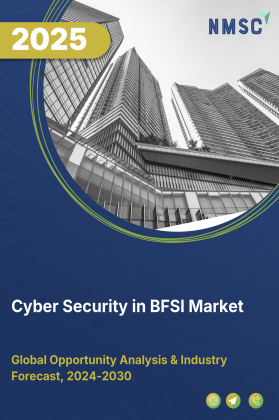
Cyber Security in BFSI Market by Component (Solutions, Services), by Technology (AI-Enabled Cybersecurity Solutions, Zero Trust/SASE Architectures, Post-Quantum Cryptography Readiness, Cloud-Native Security), by Deployment Model (On-Premises, Cloud-Based, Hybrid), by Enterprise Size (Large Enterprises, Small & Medium Enterprises), by End User (Banks, Insurance Companies, Investment Firms, NBFCs, Others) – Global Opportunity Analysis and Industry Forecast, 2025–2030
Industry Outlook
The global Cyber Security in BFSI Market size is estimated at USD 77.76 billion in 2024 and is estimated to reach USD 95.50 billion in 2025 and is predicted to reach USD 266.67 billion by 2030 with a CAGR of 22.8% from 2025-2030.
The cybersecurity in BFSI market is witnessing strong growth, driven by the rapid adoption of digital banking, fintech platforms, and cloud-based solutions, which have expanded the sector’s digital footprint and heightened exposure to cyber threats. Increasingly sophisticated attacks such as ransomware, phishing, and data breaches are compelling financial institutions to adopt advanced measures like AI-powered monitoring, multi-factor authentication, and real-time fraud detection to protect sensitive information and maintain customer trust. While high implementation and maintenance costs remain a significant challenge, the growing integration of AI and machine learning offers new opportunities for predictive threat detection and enhanced risk management, positioning cybersecurity as a critical enabler of digital transformation in BFSI.
Rising Digital Banking & Fintech Adoption Drives the Cyber Security in BFSI Market Growth
Rising digital banking and fintech adoption is a key driver of Cyber Security in BFSI market, as the shift toward mobile banking, online payments, digital wallets, and app-based lending has significantly expanded the sector’s digital footprint. This growing reliance on digital platforms has heightened exposure to threats such as fraud, phishing, identity theft, and data breaches, making robust cybersecurity solutions essential. To safeguard customer trust and ensure secure transactions, financial institutions are increasingly deploying advanced measures like multi-factor authentication, real-time fraud detection, and AI-powered monitoring, which in turn fuels the demand for comprehensive cybersecurity frameworks.
Increasing Cyber Threats & Sophisticated Attacks Fuels the Cyber Security in BFSI Market Demand
Increasing cyber threats and sophisticated attacks are becoming a critical driver of cybersecurity demand in the BFSI market, as financial institutions face growing risks to data, transactions, and operations.
According to the World Economic Forum in 2025, 72% of cyber leaders believe risks are rising, underscoring the urgency for stronger defences. With attacks such as ransomware, phishing, and large-scale data breaches becoming more advanced and frequent, the BFSI sector is under mounting pressure to enhance resilience. To address these escalating threats, banks, insurers, and fintech companies are investing in advanced tools like AI-driven threat detection, behavioural analytics, and continuous monitoring, ensuring stronger protection of customer trust and financial stability.
Growing Use of Cloud & Digital Transformation in BFSI Boosts the Cyber Security in BFSI Market Expansion
The growing use of cloud technologies and rapid digital transformation is a major driver of the market, as financial institutions increasingly migrate core operations, customer services, and data management to cloud-based platforms. While this shift enables greater efficiency, scalability, and innovation, it also introduces new vulnerabilities such as data breaches, unauthorized access, and misconfigured systems that expose sensitive financial information. As banks, insurers, and fintech companies adopt digital-first strategies, the need for robust cloud security solutions, data encryption, identity and access management, and real-time threat detection is becoming essential. This heightened focus on securing digital infrastructure is significantly fuelling demand for advanced cybersecurity measures across the BFSI industry.
High Implementation and Maintenance Costs Limits the Market Growth
One of the key restraints of the in the cyber security in BFSI market is the high cost associated with implementing and maintaining advanced security solutions. Financial institutions require comprehensive protection systems that include multi-layered defences, real-time monitoring, AI-driven analytics, and regulatory compliance tools, all of which demand significant investment. For small and mid-sized banks, insurers, and fintech companies, these costs be prohibitive, making it difficult to deploy enterprise-grade solutions at scale. Additionally, ongoing expenses for system upgrades, skilled cybersecurity professionals, and continuous monitoring further add to the financial burden, which slow down the adoption of advanced cybersecurity frameworks despite the growing threat landscape.
Adoption of AI and Machine Learning in Cybersecurity Creates New Growth Opportunities
A key opportunity for the market lies in the growing adoption of AI and machine learning technologies. As cyber threats become more complex and harder to detect with traditional tools, AI-driven systems analyse massive volumes of data in real time, identify unusual patterns, and predict potential breaches before they occur. Machine learning models continuously improve their accuracy by learning from past incidents, enabling financial institutions to stay ahead of evolving attack techniques. This not only strengthens fraud detection and risk management but also enhances customer trust by ensuring safer digital transactions. The integration of AI and ML into cybersecurity frameworks presents a significant growth avenue for the cyber security in BFSI market, particularly as BFSI players accelerate their digital transformation journeys.
Market Segmentations and Scope of the Study
The market report is segmented by component, technology, deployment model, enterprise size, end user, and region. By component, it is divided into solutions and services. By technology, it includes AI-enabled cybersecurity solutions, Zero Trust/SASE architectures, post-quantum cryptography readiness, cloud-native security, and others. By deployment model, the market is classified into on-premises, cloud-based, and hybrid. By enterprise size, it is split into large enterprises and small & medium enterprises. By end user, the market covers banks, insurance companies, investment firms, others. Regional analysis includes North America, Europe, Asia Pacific, and the Rest of the World.
Geographical Analysis
In North America, one of the key drivers of the Cyber Security in BFSI market is the presence of stringent regulatory and compliance requirements. Financial institutions are mandated to comply with frameworks such as the Gramm-Leach-Bliley Act (GLBA), the Payment Card Industry Data Security Standard (PCI DSS), and various state-level data privacy laws, which enforce strict measures for protecting sensitive financial and personal data. These regulations require banks, insurers, and other financial service providers to implement advanced security protocols, continuous monitoring, and regular audits to safeguard against cyber threats. The strong regulatory environment not only compels organizations to prioritize cybersecurity investments but also accelerates the adoption of innovative solutions, making compliance a significant growth driver in the region.
In Europe, a major driver of the market is the strong emphasis on data privacy and compliance with the General Data Protection Regulation (GDPR). Financial institutions handle vast amounts of sensitive personal and financial data, and GDPR imposes strict requirements on how this information is collected, stored, processed, and protected. Non-compliance result in heavy penalties and reputational damage, pushing banks, insurers, and fintech firms to adopt advanced cybersecurity measures. The rising frequency of cyberattacks targeting European financial systems further reinforces the need for secure digital infrastructure, making GDPR-driven data protection a critical factor accelerating cybersecurity adoption across the region.
In Asia Pacific, the rapid digitalization of financial services and the expansion of online banking are key drivers of the cybersecurity market. The surge in digital payments, e-wallets, and app-based lending has transformed the region’s financial landscape, fuelled by rising smartphone adoption and supportive government initiatives.
According to IBEF in 2025, the Unified Payments Interface (UPI) has emerged as the dominant platform in India’s digital payments ecosystem, accounting for 83% of total payment volume by the end of 2024. While this growth has enhanced financial inclusion and convenience, it has also widened the attack surface for fraud, phishing, and data breaches. To address these risks and safeguard customer trust, banks, insurers, and fintech companies are increasingly investing in advanced cybersecurity solutions, making digital transformation a significant driver of market growth across Asia Pacific.
In the Rest of the World, the Cyber Security in BFSI market is primarily driven by the expansion of financial inclusion through digital platforms. Regions such as Latin America, the Middle East, and Africa are experiencing rapid growth in mobile money services, digital wallets, and app-based lending, which are helping to bring banking access to previously underserved populations. While this digital shift enhances economic participation and convenience, it also exposes financial institutions and users to growing risks of fraud, phishing, and other cyberattacks. As a result, banks, insurers, and fintech providers in these markets are increasingly adopting cost-effective and scalable cybersecurity solutions to secure transactions and build customer trust, making digital financial inclusion a strong catalyst for cybersecurity growth in the Rest of the World.
Strategic Innovations Adopted by Key Players
Key players in the cyber security in BFSI industry are strengthening their market position through major strategic acquisitions and portfolio expansion.
-
In August 2025, Cisco reported better-than-expected earnings and highlighted strong demand for AI infrastructure. This follows their USD 25 billion acquisition of Splunk, enhancing cybersecurity and analytics capabilities, beneficial for financial services’ security and compliance needs.
-
In July 2025, Palo Alto Networks announced its largest acquisition yet Israeli identity-security specialist CyberArk for about USD 25 billion. This move is aimed at building a comprehensive cybersecurity platform amid rising AI-driven threats, especially significant for BFSI clients prioritizing identity protection.
Key Benefits
-
The report provides quantitative analysis and estimations of the Cyber Security in BFSI market from 2025 to 2030, which assists in identifying the prevailing market opportunities.
-
The study comprises a deep-dive analysis of the current and future Cyber Security in BFSI market trends to depict prevalent investment pockets in the market.
-
Information related to key drivers, restraints, and opportunities and their impact on the Cyber Security in BFSI market is provided in the report.
-
Competitive analysis of the key players, along with their market share is provided in the report.
-
SWOT analysis and Porters Five Forces model is elaborated in the study.
-
Value chain analysis in the market study provides a clear picture of roles of stakeholders.
Cyber Security in BFSI Market Key Segments
By Component
-
Solutions
-
Network Security
-
Endpoint Security
-
Identity & Access Management (IAM)
-
Data Protection & Encryption
-
Application Security
-
Advanced Threat Protection (ATP)
-
Others
-
-
Services
-
Managed Security Services (MSS)
-
Professional & Consulting Services
-
Training & Awareness Programs
-
Incident Response & Risk Management Services
-
Cyber Insurance Services
-
Others
-
By Technology
-
AI-Enabled Cybersecurity Solutions
-
Zero Trust / SASE Architectures
-
Post-Quantum Cryptography Readiness
-
Cloud-Native / Infrastructure-as-Code Security
-
Others
By Deployment Model
-
On-Premises
-
Cloud-Based
-
Hybrid
By Enterprise Size
-
Large Enterprises
-
Small & Medium Enterprises
By End User
-
Banks
-
Insurance Companies
-
Investment Firms & Asset Management Companies
-
Payment Service Providers & Fintech Companies
-
Brokerage & Trading Firms
-
NBFCs (Non-Banking Financial Companies)
-
Other Financial Institutions
By Region
-
North America
-
The U.S.
-
Canada
-
Mexico
-
-
Europe
-
The UK
-
Germany
-
France
-
Italy
-
Spain
-
Denmark
-
Netherlands
-
Finland
-
Sweden
-
Norway
-
Russia
-
Rest of Europe
-
-
Asia-Pacific
-
China
-
Japan
-
India
-
South Korea
-
Australia
-
Indonesia
-
Singapore
-
Taiwan
-
Thailand
-
Rest of Asia-Pacific
-
-
RoW
-
Latin America
-
Middle East
-
Africa
-
Key Players
-
Crowdstrike
-
Check Point Software Technologies Ltd
-
Microsoft
-
Fortinet, Inc.
-
Deloitte
-
KPMG
-
Secureworks, Inc.
-
Infosys Limited
-
Akamai Technologies
-
IBM
-
Rackspace Technology
-
NTT DATA Group Corporation
-
Quick Heal Technologies Ltd.
Report Scope and Segmentation
|
Parameters |
Details |
|
Market Size in 2025 |
USD 95.50 Billion |
|
Revenue Forecast in 2030 |
USD 266.67 Billion |
|
Growth Rate |
CAGR of 22.8% from 2025 to 2030 |
|
Analysis Period |
2024–2030 |
|
Base Year Considered |
2024 |
|
Forecast Period |
2025–2030 |
|
Market Size Estimation |
Billion (USD) |
|
Growth Factors |
|
|
Countries Covered |
28 |
|
Companies Profiled |
10 |
|
Market Share |
Available for 10 companies |
|
Customization Scope |
Free customization (equivalent up to 80 working hours of analysts) after purchase. Addition or alteration to country, regional, and segment scope. |
|
Pricing and Purchase Options |
Avail customized purchase options to meet your exact research needs. |

















 Speak to Our Analyst
Speak to Our Analyst






















